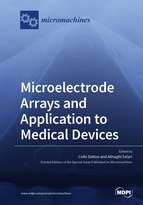Microelectrode Arrays and Application to Medical Devices
A special issue of Micromachines (ISSN 2072-666X). This special issue belongs to the section "B:Biology and Biomedicine".
Deadline for manuscript submissions: closed (1 April 2020) | Viewed by 45014
Special Issue Editors
Interests: biomedical micro devices; brain machine interfaces; electrokinetics; lab-on-a-chip; micro electrode arrays; microfluidics
Special Issues, Collections and Topics in MDPI journals
Special Issue Information
Dear Colleagues,
Microelectrode arrays are increasingly used in a wide variety of situations in the medical device sector. For example, one major challenge in microfluidic devices is the manipulation of fluids and droplets effectively at such scales. Due to the laminar flow regime (i.e., low Reynolds number) in microfluidic devices, the mixing of species is also difficult, and unless an active mixing strategy is employed, passive diffusion is the only mechanism that causes the fluid to mix. For many applications, diffusion is considered too slow, and thus many active pumping and mixing strategies have been employed using electrokinetic methods, which utilize a variety of simple and complex microelectrode array structures.
Microelectrodes have also been implemented in in-vitro intracellular delivery platforms to conduct cell electroporation on chip, where a highly localized electric field on the scale of a single cell is generated to enhance the uptake of extracellular material. In addition, microelectrode arrays are utilized in different microfluidic biosensing modalities where a higher sensitivity, selectivity, and limit-of-detection are desired. Carbon nanotube microelectrode arrays are used for DNA detection, multi-electrode array chips are used for drug discovery, and there has been an explosion of research into brain–machine interfaces, fueled by microfabricated electrode arrays, both planar and three-dimensional.
The advantages associated with microelectrode arrays include small size, the ability to manufacture repeatedly and reliably tens to thousands of micro-electrodes on both rigid and flexible substrates, and their utility for both in vitro and in vivo applications. To realize their full potential, there is a need to develop and integrate microelectrode arrays to form useful medical device systems.
As the field of microelectrode array research is wide, and touches many application areas, it is often difficult to locate a single source of relevant information. This Special Issue seeks to showcase research papers, short communications, and review articles that focus on the application of microelectrode arrays in the medical device sector. Particular interest will be paid to innovative application areas that can improve upon existing medical devices, such as for neuromodulation and real world lab-on-a-chip applications.
Dr. Colin Dalton
Dr. Alinaghi Salari
Guest Editor
Manuscript Submission Information
Manuscripts should be submitted online at www.mdpi.com by registering and logging in to this website. Once you are registered, click here to go to the submission form. Manuscripts can be submitted until the deadline. All submissions that pass pre-check are peer-reviewed. Accepted papers will be published continuously in the journal (as soon as accepted) and will be listed together on the special issue website. Research articles, review articles as well as short communications are invited. For planned papers, a title and short abstract (about 100 words) can be sent to the Editorial Office for announcement on this website.
Submitted manuscripts should not have been published previously, nor be under consideration for publication elsewhere (except conference proceedings papers). All manuscripts are thoroughly refereed through a single-blind peer-review process. A guide for authors and other relevant information for submission of manuscripts is available on the Instructions for Authors page. Micromachines is an international peer-reviewed open access monthly journal published by MDPI.
Please visit the Instructions for Authors page before submitting a manuscript. The Article Processing Charge (APC) for publication in this open access journal is 2600 CHF (Swiss Francs). Submitted papers should be well formatted and use good English. Authors may use MDPI's English editing service prior to publication or during author revisions.
Keywords
- Micro Electrode Array
- Biomedical Micro Devices
- Brain Machine Interfaces
- Electrokinetics
- Lab-on-a-Chip
- Microfluidics
- Neuromodulcation
- Biosensors
- Micropumps
- Micromixing
- Electrothermal
- Electroosmosis
- Dielectrophoresis







